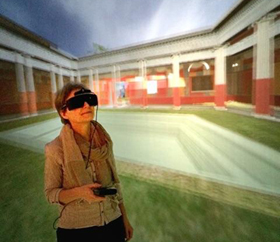 In the DiVE, Duke Immersive Virtual Environment, courtesy of David J. Zielinski. Photo by Victoria Szabo, 12 Nov 2014.
In the DiVE, Duke Immersive Virtual Environment, courtesy of David J. Zielinski. Photo by Victoria Szabo, 12 Nov 2014.
My career as an art historian spans some 30 years. I hold Master’s degrees in the History of Art (1980, University of Warsaw) and Computing Applications for the History of Art (1994, Birkbeck College, University of London). I completed my Ph.D. in Digital Media Studies in 1998 at Southampton Institute/Nottingham Trent University. My specialism is often defined as Digital Art History. I work internationally – by invitation – as an independent scholar and lecturer, post-graduate supervisor and examiner, author and editor, consultant and academic reviewer. I also enjoy writing art criticism.
I am interested in the creative use of digital technologies in art practice and the scholarly use of digital technologies in art studies, particularly the applications of 3/4D computer graphics and machine haptics. I research the history of this field and explore its future in collaboration with scientists, engineers and researchers from other disciplines. The creative interaction with space — both natural or man-made; historic or present — has been a common theme to many of my research projects. How space has been interpreted and represented by artists and architects, in early-modern visual culture and beyond, and what are the art historian’s tools to examine artistic compositions and meanings thus created.
My Ph.D. thesis (1998) was concerned with a computer-aided iconological study of anthropomorphic landscapes in Western art, 1560s-1660s. It was considered pioneering at that time, both in terms of the subject and methodology. I looked at the iconography of landscapes — paintings, drawings, prints, scientific illustrations and garden designs — represented in human form. I proposed a cosmological interpretation of possible contemporary meanings of this curious double imagery. I established digital iconology as an analytical and interpretative methodology for this type of study, employing image processing techniques, multimedia discourse and classification based on content-based image retrieval (CBIR) that can be applied when traditional classification criteria used in art history prove unreliable.
Since the early 1990s I have been involved in a number of major interdisciplinary, computer-based projects hosted, among others, by the British Academy/Courtauld Institute of Art in London (2000-2008), National Maritime Museum in Greenwich and King’s College London (2000-2015). The network ‘Colour and Space in Cultural Heritage’ (COSCH), 2012-2016, of which I was Vice-Chairman, provided a forum for interdisciplinary research. It was a trans-domain Action in Materials, Physics and Nanosciences, supported by the European Cooperation in Science and Technology.
From 2000 to 2015 I was a part-time researcher and lecturer in Digital Art History in the Department of Digital Humanities (formerly the Centre for Computing in the Humanities) at King’s College London. I was Director for Digital Art History; Digital Arts and Culture; and Digital Visualisation – three modules of the M.A. programmes in Digital Humanities and Material Culture and Society respectively. I retired from active academic life in 2015. I continue to offer supervision and act as examiner of Ph.D. students researching art and technology, the history of computer-based art practice and the history of applications of digital technologies to the history of art.
In the 1980s I worked as Assistant Curator in the Painting Department of the Royal Castle in Warsaw, specialising in reconstruction of historic interiors and restitution of art collections. This fascinating work influenced my later interest in computer-based historic visualisation, its technical complexity and demand for scholarly transparency — as opposed to artistic license.
Editorial Advisory Boards
I was a committee member of the Computers and the History of Art (CHArt) between 1999-2015 and served as CHArt Editor-in-Chief. Since 2013 I have served on the Advisory Board for the Polish National Institute for Museums and Public Collections (NIMOZ). I was appointed Editor-in-Chief of the Polish edition of the Art and Architecture Thesaurus, a Getty Research Institute’s controlled vocabulary. The current hiatus in the latter, much needed project is due to lack of funding.
Computers and the History of Art, 1999-2015
The Art Book, 2000-2003
Digital Art History, 2014-
Muzealnictwo, 2014-
Visual Resources. International Journal of Documentation, 2014-
Academic Reviewing, inter alia, for
ACM Journal on Computing and Cultural Heritage
Belgian Research Action through Interdisciplinary Networks (BRIAN), Belgian Science Policy Office
Deutsche Forschungsgemeinschaft (DFG)
Digital Scholarship in the Humanities, Oxford University Press
Intellect Books
Routledge
Springer Books in Computer Science
UK Arts and Humanities Research Council
US National Research Council; Division on Engineering and Physical Sciences; Computer Science and Telecommunications Board; Committee on Information Technology and Creativity
Professional Memberships
Stowarzyszenie Historykow Sztuki, Poland
Association of Art Historians, UK, 2001-2019, ordinary member and the Independents’ Committee member. I advocated for the introduction of grants for the members and eventually administered the AAH Image Reproduction Rights Grant, 2009-2012.
October 25, 2012 at 9:13 am
[…] event is curated and presented by Drew Baker, Anna Bentkowska-Kafel, Martin Blazeby, Hugh Denard and Michael Takeo Magruder. For more information, visit the KCL […]